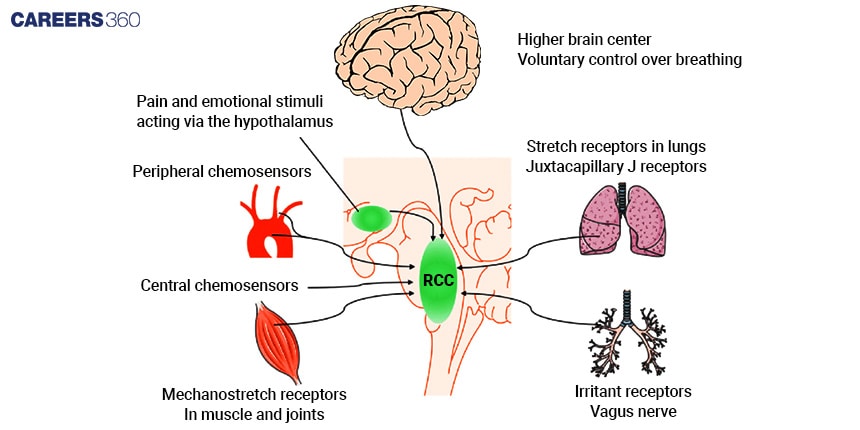Regulation Of Respiration: Definition, Function And Diagram
What Is Respiration?
Respiration is an essential physiological activity that preserves the optimum level of oxygen and carbon dioxide within the body. This article elaborates on mechanisms and factors for the control of respiration, so it's a very essential material for examinations like NEET preparation.
Neural Control Of Respiration

Respiration is controlled by respiratory centres located in the brain stem.
Respiratory Centers In The Brain
The medullary respiratory centre includes the dorsal and ventral respiratory groups. Thus, the DRG establishes the fundamental rhythm of breathing, while the VRG does Voluntary breathing.
What Is The Role Of The Medullary Respiratory Center?
The medullary respiratory centre coordinates patterns of breathing in response to information received through sensory input.
Role Of The Pontine Respiratory Group
The pontine respiratory group sharpens the breath rhythm into transitions between inspiration and expiration and vice versa.
Chemical Regulation Of Respiration
The chemoreceptors monitor oscillations in the blood's CO2, O2, and pH levels. Sensory input regarding these variables is subsequently sent to the CPG with commands to either raise or lower the breathing cycle to re-balance the concentration of chemicals back to homeostatic levels within the body.
Chemoreceptor Function
The central chemoreceptors are in the medulla sensitive to changes in CO2. In contrast, peripheral chemoreceptors that lie in the carotid bodies and aortic bodies are sensitive to O2 and pH
The Effects Of Co2, O2, And Ph Level On Respiration
High concentration of CO2 rate of breathing increases;
When the rate of breathing becomes too low with the low concentration of oxygen, then peripheral chemoreceptors start shifting breathing
Respiratory Regulation Mechanisms
The body uses multiple feedback systems to govern breathing efficiently.
Feedback Systems In Respiratory Control
These involve sensors that sense changes, control centres that change the rate and depth of respiration, and the effectors that carry out the ultimate response—respiratory homeostasis.
Hering-Breuer Reflex
This reflex prevents overinflation of the lungs by inhibiting the inspiratory neurons through the activation of stretch receptors in the lungs.
Role Of Proprioceptors When The Body Is Exercising
Proprioceptors in muscles and joints stimulate the respiratory centres to increase the rate of breathing during exercise.
Factors Affecting Respiration
There are some factors which influence the rate of respiration and the depth of respiration.
Physical Factors
The respiration rate will increase to provide a greater amount of oxygen to the muscle due to exertion.
Emotional Factors
Stress and anxiety may affect breathing patterns, in which, usually the rate of respiration will be increased.
Chemical Factors
The blood levels of CO2, O2 and pH directly vary and impact respiration
Diseases Of Respiratory Control
Familiarity with the most common diseases will help you recognize and manage disorders of respiratory control
Most Common Diseases
Sleep apnea and respiratory depression represent two diseases that involve alterations of normal respiratory control
Agent And Effect Of Dis-Ordered Respiration
This can be caused by damage to nerves, imbalance in chemicals, or sometimes even by not providing the correct amount of oxygen to tissues.
Recent Research Progress In Respiratory Control
The continuous research in respiratory control has come up with many breakthroughs. These include the following:
New Insights Into The Control Of Breathing
Not long ago, the discovery of many new molecular pathways and mechanisms of participation in breathing control was made.
The Technological Advancement In The Monitoring Of Respiratory Functions
New inventions in medical technology have widened the scope of managing and monitoring existing respiratory disorders.
Recommended video on Regulation Of Respiration
Frequently Asked Questions (FAQs)
The rate of respiration would be raised to meet the enhanced oxygen demands of the muscles in the event of muscular exercise.
Examples include sleep apnea, respiratory depression, and disorders such as those resulting in nerve damage or chemical imbalance that damages respiratory control.
Mainly, it is the medullary respiratory centre and the pontine respiratory group: DRG and VRG.
Chemoreceptors continuously monitor the CO2 and O2 levels and pH and make requisite changes in the respiratory rate to maintain homeostasis.
The medullary respiratory centre integrates sensory input to modulate respiratory patterns to maintain a stable breathing rhythm.